Living as foreigners in Tokyo, we all make choices about how much Japanese lifestyle we want to incorporate into our own lives on a regular (if not daily) basis. Should we have spaghetti for dinner or yakisoba? Should we explore a new part of the city this weekend, or just stick close to home and do something easy? We all know it’s very simple to just do the latter and make the easy choice - no confusing maps, no language barrier… But, for many people, the most incredible experiences we will have in Japan come from stepping beyond the comfortable ex-pat bubble. The same holds true for our children.
We can let our kids hop off of the school bus every day, watch “Sponge Bob” on TV, and eat McDonald’s for dinner, and they’ll be very happy with life in Tokyo. Or, we can encourage them to take a step into Japanese life, and try to really experience the culture that surrounds us. Here are five stories of “gaijin” children who have immersed themselves in some aspect of Japanese life. A dancer, a preschooler, a baseball player, a drummer, and an elementary school student…what they all have in common is this: they have experienced a slice of Japanese life that most of us will never have the opportunity to fully comprehend. Their lives are richer, and someday maybe they’ll look back and thank their parents for that!
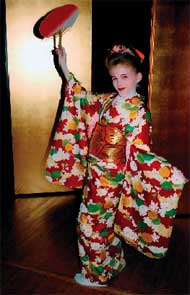
Julia says she was mesmerized from the moment she laid eyes on this beautiful art form. After repeatedly asking for dance lessons, Julia, (age 10) finally entered the temple for her first lesson. The rest, as they say, is history, and from this initial introduction to Japanese dance bloomed an all out passion.
Julia takes lessons from the accomplished dancer and teacher, Hattori Mako-san, and also from the Yamamura-ryu School’s Iemoto (Dance Master), who travels from Osaka to teach Tokyo students. Unlike Western dance, students of Japanese dance learn individual dances chosen
for them, and learn not by verbal instruction but by dancing beside the teacher, imitating their every move. Julia says she can be dancing for up to three hours!
As with all Japanese arts, the art itself is a mere part of the many intertwined aspects of Japanese culture. For Julia, learning about kimono is as interesting as the dancing. Two of her biggest accomplishments have been learning to dress herself in yukata, and mastering tying the long obi. With a recital quickly approaching, Julia is hoping that after the many hours of practice, her tabi clad feet will be ready to take their measured steps in time to the sound of the Japanese shamisen.
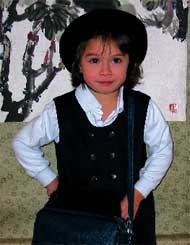
Taylor is truly an example of an international child. Although she is only 4 years old, she has already lived in three countries and is learning her third language. Taylor is American by birth, but lived in the U.S. for just a short time before she and her family moved to Mexico City. Because both of Taylor’s parents had enriching experiences living abroad as children, they feel strongly about their children embracing the cultures in which they live. For that reason, when they moved to Tokyo about a year ago, they enrolled Taylor in Minato Yochien.
Although the language barrier was initially a challenge for Taylor at her new school, once she got a handle on it, she settled in quite well. However, she wasn’t the only family member who needed to make some adjustments. Parents are expected to attend several meetings each week at the school, and definitely need to be able to read and speak at least some Japanese. Taylor’s parents have found that the school faculty and other parents make great efforts to bridge the cultural and language gaps, which has made the transition much smoother. Now that Taylor is happily nearing the completion of her first year at Yochien, she is speaking Japanese with ease and has made many friends in her class. The only downside is that her Spanish is fading!
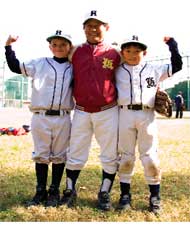
Back in the States, John started playing baseball when he was 6 years old. After moving to Tokyo two years ago at the age of 8, John played in the Tokyo American Club league and thoroughly enjoyed it. But, the program was seasonal, and that simply wasn’t enough baseball for him. John’s parents looked into the local league, and found the Honmura team, part of the league for children living in Minato-ku. John is now one of three “gaijin” kids on the team.
What’s so different about playing on a Japanese baseball team? For one thing - the commitment! The team plays three times per week - rain or shine. John is also learning a great deal about respect, as part of the team. He must take off his hat and bow to the field whenever he walks on and off of it, as the field is seen as sacred ground. He bows to the umpire when he goes to the plate. When his coaches speak, his hat is tucked under his arm and he is at full attention. In addition to improving his game considerably, being part of the team has also taught John a great deal about respect and teamwork.
But is it fun? Absolutely! John has learned enough Japanese to not only understand his coaches, but also to joke around with his teammates.
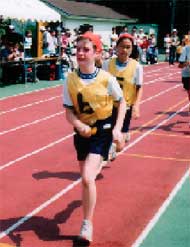
At the age of 8, Kariko entered 3rd grade in a Japanese school after moving to Tokyo from Boston, Massachusetts. Speaking no Japanese, Kariko felt a little nervous at first simply because everything at school was new. However, after two years of doing school work in a mixture of Japanese and English, by 5th grade Kariko was working entirely in Japanese and speaking confidently in class.
In addition to all of the hard work at school, there is certainly a lot of fun as well. Kariko (originally Kari, but her Japanese friends added the “ko!”) really enjoys the very organized annual Sports Day (undoukai), and the class trip to Hakone. Sports are taken seriously at Japanese schools, and there are strict practices throughout the year. All of this hard work paid off however, when Kariko’s school team won the Minato-ku basketball championship! Lunchtime is also taken seriously, and students are expected to finish the healthy Japanese hot lunch (kyoshoku) before being allowed out for recess.
Kariko would definitely recommend this experience. Kariko really appreciates how her world has opened up, and is aware of just how many more things she can do in Japan since becoming fluent in the language. She appreciates the exposure to so many more aspects of Japanese culture, and especially enjoys making friends with the Japanese children in her school and neighbourhood.
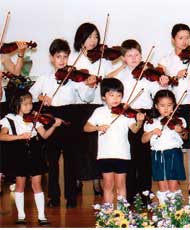
Brothers Henry (11) and George (10) have been studying Suzuki violin in Japan for five years. Sometimes called the “mother-tongue” approach, the Suzuki method stresses parent involvement, an early beginning, listening, repetition, and encouragement. Henry and George take both individual and group lessons, all taught in Japanese, at their sensei’s traditional style home. Each lesson begins and ends with bows and
greetings of respect. Sensei says, “Students” only have to practice on days that they eat,” and if they feel unwell, he recommends playing even more to feel better!
The annual recital incorporates all 50 of the sensei’s students, and lasts three hours. Three to four concerts are held throughout the year, including the “Suzuki Grand Concerts” with 3000 violinists, and the 2004 Grand Concert - where performers played for the Emperor and Empress. The brothers’ favorite annual concert is in Ibaraki-ken at a strawberry farm, playing amongst the strawberry plants!
Violin has really been a “cultural bridge” for Henry and George, as they participate in a Suzuki Summer Institute in America on their summer home leave, and play violin alongside Japanese children the rest of the year. Both boys agree their closest friends are their “violin friends.” They think making music is fun, but making friends is even better!





